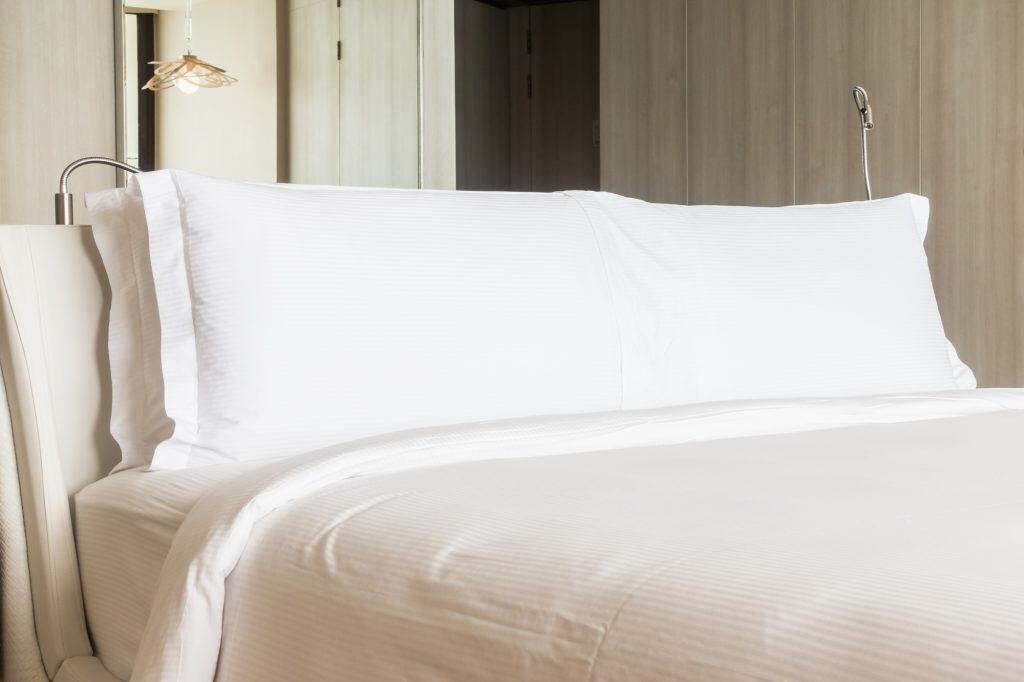Bedding / Sleep Advice
What Exactly is a Bed Sham?
Often overlooked when people think of bedding, bed shams are a design element that can elevate a bedroom’s aesthetics. Unlike its close relative, the pillowcase, a decorative bed sham serves the dual purpose of adding beauty and functionality. This article will explore decorative bed coverings, examining their history and practical uses. We will also shed light on these often misunderstood items and provide tips on choosing, styling, and caring for them to elevate your bedroom’s decor.
1. What is a Bed Sham?
Bed shams are decorative pillow covers designed to elevate the look of your bedding. They come in various styles, featuring intricate patterns, embellishments, and interesting closures like flaps or zippers. Unlike standard pillowcases, which prioritize comfort and function, shams are crafted from higher-quality fabrics that can hold their shape and design, ensuring they stay looking sharp even if they’re purely for show.
Primarily decorative, bed shams elevate the aesthetics of a bedroom by transforming standard bedding into an attractive display. While some shams are explicitly designed for decorative throw pillows, they also come in various sizes to fit standard, queen, or king-sized pillows.
2. Bed Shams’ Historical Roots

Bed shams are said to date back to eighteenth-century Europe, where the nobility used them as a symbol of wealth and to represent their status. Originally called “sham pillows,” these decorative covers added to the grandeur of upper-class and aristocratic bedrooms and often featured luxurious fabrics like silk and richly decorative shuttle-woven fabrics. They were also usually decorated with lace and intricate embroidery.
Over the past three centuries, the bed sham’s popularity has defied class systems and become a common decorative element in bedrooms for anyone interested in home décor. Today, they remain a popular element in bedrooms because of their historical association with elegance and attention to detail.
3. Bed Shams vs. Pillowcases

While both bed shams and pillowcases are essentially pillow covers, the similarities end there. Regular pillowcases are designed to be functional, protect your pillow, and provide a clean surface to sleep on. They are usually made of a softer, more breathable material than bed shams, like cotton or linen, and their designs are usually simpler so they are more comfortable and easier to clean.
On the other hand, bed shams are designed to enhance your interior décor style and often feature elaborate designs, including trims, ruffles, or borders. They are also typically made from heavier, more decorative fabric, and because of this aspect, they are not typically designed to be slept on but instead are taken off the bed and put away at night.
4. Choosing the Right Bed Sham
Selecting the right bed sham can be fun but daunting because of the many different fabrics, patterns, and sizes available. When choosing a sham, think about your bedroom’s overall theme and its color scheme—this is important because the aim is for it to complement your bedspread or duvet cover by either matching it or adding a pop of color through a design or pattern that ties the room together.
The material your sham is made of is also important—it should not only be aesthetically pleasing but also suit your climate and lifestyle. For example, a velvet sham might be perfect for a colder climate or a luxury-themed bedroom, but a lighter fabric like linen would be ideal for warmer weather and a more casual-looking sham.
5. How to Style Bed Shams for Maximum Effect
Using bed shams to add extra style not just adds to the style of your bed but also the overall appearance of the décor of your bedroom. If you like a traditional look, stack your sham-covered pillows against your headboard and layer them in front of the pillows you sleep on. In doing so, this arrangement will add to your bed’s appearance. On the other hand, if you like a more modern, minimalistic approach, try using just one or two large shams as the sole decorative elements on your bed.
You can also combine different textures and patterns with your bed shams to introduce a more dynamic aesthetic in your bedroom decor. If you’re playing with the textures and different patterns, don’t be afraid to combine floral patterns with stripes or solid colors—the idea is to maintain a cohesive color palette to bring the different elements together rather than clash.
6. Care and Maintenance Tips for Bed Shams

Looking after your bed shams requires a bit more effort than how you would wash your regular pillow covers. Because they can be so decorative and the materials used, shams often require special care to ensure the texture and colors last. It’s always a good idea to follow the manufacturer’s care instructions—which you will find on the label attached to the pillow. Generally, most shams should be washed on a gentle cycle to avoid causing any holes or tearing and so none of the delicate embellishments fall off, something that is especially important for delicate fabrics like silk or brocade.
If you use bed shams to decorate your bedroom, it’s a good idea to rotate them regularly to prevent wear and tear. When not in use, store your shams in a cool, dry place away from direct sunlight so they don’t fade and to preserve the delicate materials. Ensuring you care for your shams properly means your bed shame should remain an enduring and beautiful part of your bedroom decor for years.
With their long and rich history and decorative appeal, bed shams are more than just additional decor for your bedroom—they symbolize a three-hundred-year-long tradition of elegance and comfort. Whether revamping your bedroom or looking for a beautiful final touch to add to your bedding, bed shams are versatile and often striking. By choosing the right ones, styling them properly, and caring for them well, your bed shams can transform what was once a plain bedroom into a decorative retreat, proving that the beauty and mystery of bed shams are worth diving into.

